- 1Docker 使用方法总结之:管理工具 shipyard 的详细使用指南_shipyard 使用
- 2计算机设计大赛 深度学习YOLOv5车辆颜色识别检测 - python opencv
- 3一键搭建网站(网站源码)_xui面板搭建官网
- 4UE4从零开始的卡通渲染——阴影篇(二)_ue风格化角色脸部光影过度
- 5el-select与el-option插槽样式自定义_el-select 插槽
- 6selenium还能这么玩:连接已经存在的浏览器_selenium使用已打开的浏览器
- 7vue - el-table 实现 选择框禁止功能_写一个简单的 vue 页面,实现选择框选中时,下拉选择框禁用的功能
- 8求解微分方程的人工智能与深度学习方法:现状及展望_深度学习微分方程
- 9移动端Alpha Test费性能的原因_移动端 alphatest与translucent
- 10收集的图形学面试问题小结资料_计算机图形学面试题
Spring Boot整合Redis_springboot redis
赞
踩
文章目录
一、Redis概述
Redis是一个开源(BSD许可)的、内存中的数据结构存储系统,它可以用作数据库、缓存和消息中间件,并提供多种语言的API。
Redis支持多种类型的数据结构,如 字符串(strings)、散列(hashes)、列表(lists)、集合(sets)、有序集合(sorted sets)与范围查询、bitmaps、 hyperloglogs 和 地理空间(geospatial)、索引半径查询。
Redis 内置了复制(replication),LUA脚本(Lua scripting),LRU驱动事件(LRU eviction),事务(transactions) 和不同级别的磁盘持久化(persistence), 并通过 Redis哨兵(Sentinel)和自动 分区(Cluster)提供高可用性(high availability)。
Redis官网与在线教程
官网:https://redis.io/
中文网站:http://www.redis.cn/
在线教程:https://www.redis.net.cn/tutorial/3502.html
二、使用Spring Boot 整合 Redis
(一)搭建Redis环境
(二)下载和安装Redis可视化管理工具
(三)创建Spring Boot项目RedisDemo
设置项目配置
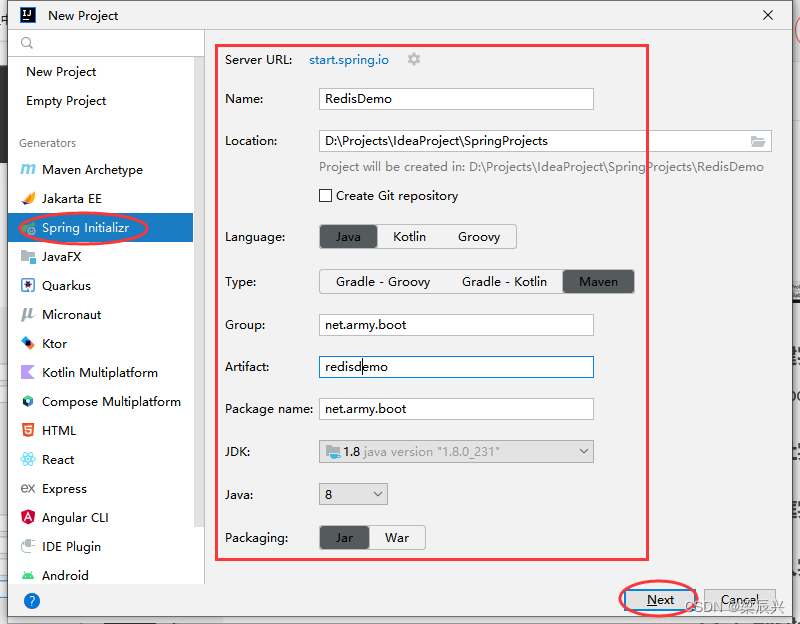
添加项目依赖
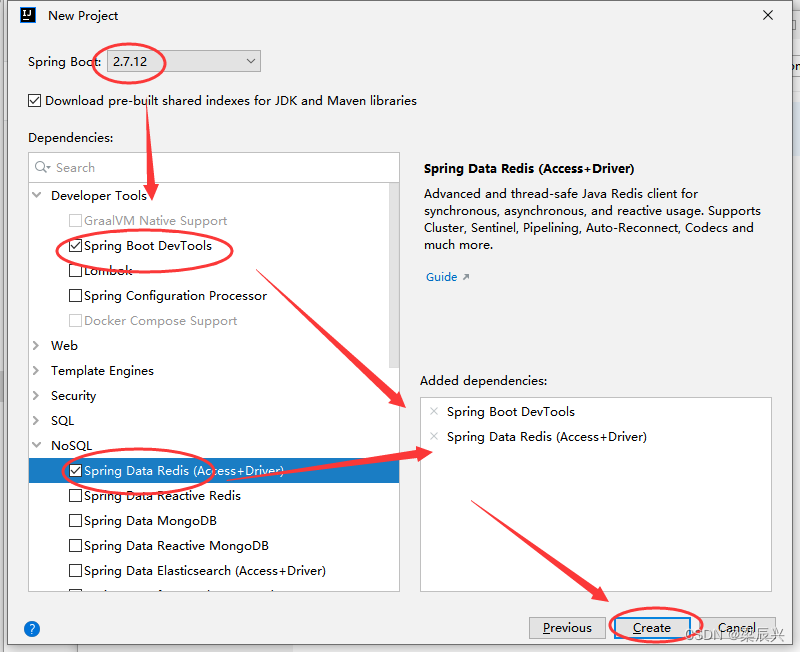
完成项目初始化

(四)创建实体类
在net.army.boot包里创建bean子包
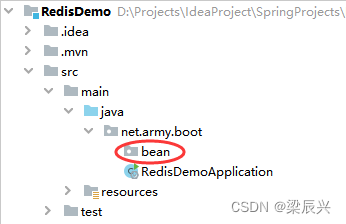
1、创建地址实体类 - Address
在net.army.boot.bean包里创建地址实体类Address
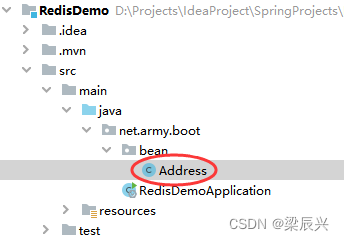
package net.army.boot.bean;
import org.springframework.data.redis.core.index.Indexed;
/**
* 功能:地址实体类
* 日期:2023年06月16日
* 作者:梁辰兴
*/
public class Address {
@Indexed
private String country; //国家
@Indexed
private String city; //城市
public Address(String country, String city) {
this.country = country;
this.city = city;
}
public String getCountry() {
return country;
}
public void setCountry(String country) {
this.country = country;
}
public String getCity() {
return city;
}
public void setCity(String city) {
this.city = city;
}
@Override
public String toString() {
return "Address{" +
"country='" + country + '\'' +
", city='" + city + '\'' +
'}';
}
}
- 1
- 2
- 3
- 4
- 5
- 6
- 7
- 8
- 9
- 10
- 11
- 12
- 13
- 14
- 15
- 16
- 17
- 18
- 19
- 20
- 21
- 22
- 23
- 24
- 25
- 26
- 27
- 28
- 29
- 30
- 31
- 32
- 33
- 34
- 35
- 36
- 37
- 38
- 39
- 40
- 41
- 42
- 43
- 44
注意:索引类Indexed不要导入错误 - import org.springframework.data.redis.core.index.Indexed;
2、创建家庭实体类 - Family
在net.army.boot.bean包里创建家庭实体类Family
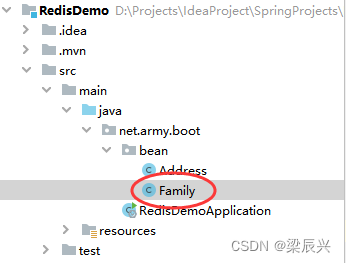
package net.army.boot.bean;
import org.springframework.data.redis.core.index.Indexed;
/**
* 功能:家庭实体类
* 日期:2023年06月16日
* 作者:梁辰兴
*/
public class Family {
@Indexed
private String type; //成员类型
@Indexed
private String name; //成员名
public Family(String type, String name) {
this.type = type;
this.name = name;
}
public String getType() {
return type;
}
public void setType(String type) {
this.type = type;
}
public String getName() {
return name;
}
public void setName(String name) {
this.name = name;
}
@Override
public String toString() {
return "Family{" +
"type='" + type + '\'' +
", name='" + name + '\'' +
'}';
}
}
- 1
- 2
- 3
- 4
- 5
- 6
- 7
- 8
- 9
- 10
- 11
- 12
- 13
- 14
- 15
- 16
- 17
- 18
- 19
- 20
- 21
- 22
- 23
- 24
- 25
- 26
- 27
- 28
- 29
- 30
- 31
- 32
- 33
- 34
- 35
- 36
- 37
- 38
- 39
- 40
- 41
- 42
- 43
- 44
3、创建个人实体类 - Person
在net.army.boot.bean包里创建个人实体类Person
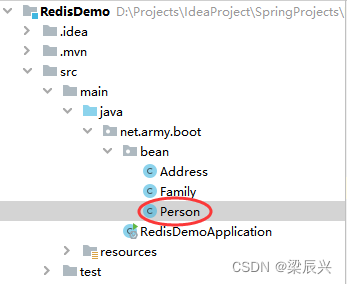
package net.army.boot.bean;
import org.springframework.data.annotation.Id;
import org.springframework.data.redis.core.RedisHash;
import org.springframework.data.redis.core.index.Indexed;
import java.util.List;
/**
* 功能:个人实体类
* 日期:2023年06月16日
* 作者:梁辰兴
*/
@RedisHash("persons")
public class Person {
@Id //主键
private String id;
//生成二级索引,方便查询
@Indexed
private String firstName; //名
@Indexed
private String lastName; //姓
private Address address; //家庭地址
private List<Family> familyList; //家庭成员
public Person(String id, String firstName, String lastName, Address address, List<Family> familyList) {
this.id = id;
this.firstName = firstName;
this.lastName = lastName;
this.address = address;
this.familyList = familyList;
}
public String getId() {
return id;
}
public void setId(String id) {
this.id = id;
}
public String getFirstName() {
return firstName;
}
public void setFirstName(String firstName) {
this.firstName = firstName;
}
public String getLastName() {
return lastName;
}
public void setLastName(String lastName) {
this.lastName = lastName;
}
public Address getAddress() {
return address;
}
public void setAddress(Address address) {
this.address = address;
}
public List<Family> getFamilyList() {
return familyList;
}
public void setFamilyList(List<Family> familyList) {
this.familyList = familyList;
}
@Override
public String toString() {
return "Person{" +
"id='" + id + '\'' +
", firstName='" + firstName + '\'' +
", lastName='" + lastName + '\'' +
", address=" + address +
", familyList=" + familyList +
'}';
}
}
- 1
- 2
- 3
- 4
- 5
- 6
- 7
- 8
- 9
- 10
- 11
- 12
- 13
- 14
- 15
- 16
- 17
- 18
- 19
- 20
- 21
- 22
- 23
- 24
- 25
- 26
- 27
- 28
- 29
- 30
- 31
- 32
- 33
- 34
- 35
- 36
- 37
- 38
- 39
- 40
- 41
- 42
- 43
- 44
- 45
- 46
- 47
- 48
- 49
- 50
- 51
- 52
- 53
- 54
- 55
- 56
- 57
- 58
- 59
- 60
- 61
- 62
- 63
- 64
- 65
- 66
- 67
- 68
- 69
- 70
- 71
- 72
- 73
- 74
- 75
- 76
- 77
- 78
- 79
- 80
- 81
- 82
- 83
- 84
说明:注解@RedisHash(“persons”),表明在redis数据库中开启一个persons的内存空间,所有person操作相关的数据均保存在此空间(redis是内存数据库)。
(五)创建仓库接口 - PersonRepository
在net.army.boot包里创建repository子包,再在子包下创建PersonRepository接口
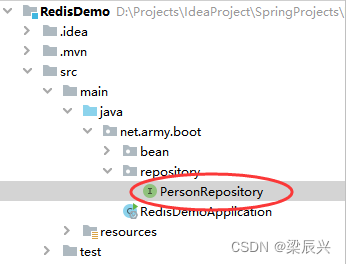
package net.army.boot.repository;
import net.army.boot.bean.Person;
import org.springframework.data.repository.CrudRepository;
/**
* 功能:个人仓库接口
* 日期:2023年06月16日
* 作者:梁辰兴
*/
public interface PersonRepository extends CrudRepository<Person, String> {
}
- 1
- 2
- 3
- 4
- 5
- 6
- 7
- 8
- 9
- 10
- 11
- 12
(六)在全局配置文件配置Redis属性
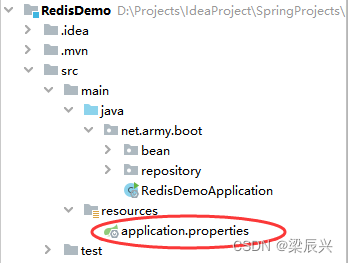
spring.redis.port=6379
spring.redis.host=127.0.0.1
spring.redis.password=
- 1
- 2
- 3
(七)在测试类里编写测试方法
点开测试类RedisDemoApplicationTests
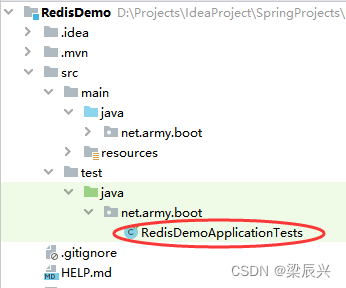
注入PersonRepository实例

@Autowired // 注入个人仓库
private PersonRepository personRepository;
- 1
- 2
1、创建测试方法testAddPerson()
@Test
public void testAddPerson() {
// 添加第一个人
Address address = new Address("中国", "泸州");
Family family1 = new Family("儿子", "张晓刚");
Family family2 = new Family("女儿", "张晓霞");
List<Family> familyList = new ArrayList<Family>();
familyList.add(family1);
familyList.add(family2);
Person person = new Person("1", "无忌", "张", address, familyList);
personRepository.save(person);
// 添加第二个人
address = new Address("中国", "上海");
family1 = new Family("儿子", "李功晨");
family2 = new Family("女儿", "李晓丽");
familyList = new ArrayList<Family>();
familyList.add(family1);
familyList.add(family2);
person = new Person("2", "承鹏", "李", address, familyList);
personRepository.save(person);
// 添加第三个人
address = new Address("中国", "北京");
family1 = new Family("儿子", "唐玉海");
family2 = new Family("女儿", "唐雨涵");
familyList = new ArrayList<Family>();
familyList.add(family1);
familyList.add(family2);
person = new Person("3", "大明", "唐", address, familyList);
personRepository.save(person);
// 添加第四个人
address = new Address("中国", "北京");
family1 = new Family("儿子", "张大明");
family2 = new Family("女儿", "张丽丽");
familyList = new ArrayList<Family>();
familyList.add(family1);
familyList.add(family2);
person = new Person("4", "文勇", "张", address, familyList);
personRepository.save(person);
System.out.println("成功地添加了4条记录~");
}
- 1
- 2
- 3
- 4
- 5
- 6
- 7
- 8
- 9
- 10
- 11
- 12
- 13
- 14
- 15
- 16
- 17
- 18
- 19
- 20
- 21
- 22
- 23
- 24
- 25
- 26
- 27
- 28
- 29
- 30
- 31
- 32
- 33
- 34
- 35
- 36
- 37
- 38
- 39
- 40
- 41
- 42
- 43
- 44
运行测试方法,查看结果

打开Redis可视化工具查看


2、创建测试方法testFindAll()
@Test
public void testFindAll() {
Iterable<Person> persons = personRepository.findAll();
persons.forEach(person -> System.out.println(person));
}
- 1
- 2
- 3
- 4
- 5
运行测试方法,查看结果

3、测试personRespository的其它方法
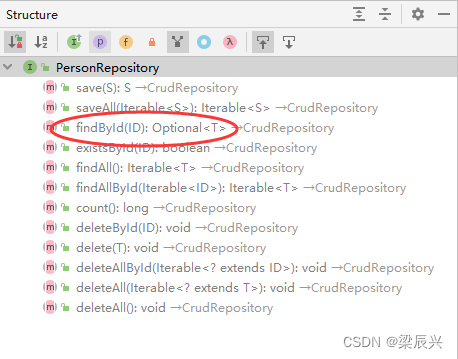
创建测试方法testFindById()
@Test
public void testFindById() {
Optional<Person> person = personRepository.findById("2");
System.out.println(person);
}
- 1
- 2
- 3
- 4
- 5
运行测试方法,查看结果

(八)测试自定义个性化查询方法
1、在PersonRepository接口定义方法
package net.army.boot.repository;
import net.army.boot.bean.Person;
import org.springframework.data.domain.Page;
import org.springframework.data.domain.Pageable;
import org.springframework.data.repository.CrudRepository;
import java.util.List;
/**
* 功能:个人仓库接口
* 日期:2023年06月16日
* 作者:梁辰兴
*/
public interface PersonRepository extends CrudRepository<Person, String> {
//自定义个性化查询,方法名需要符合特定的规范
List<Person> findByLastName(String lastName);
Page<Person> findPersonByLastName(String lastName, Pageable pageable);
List<Person> findPersonByLastNameAndFirstName(String lastName, String firstName);
List<Person> findByAddress_City(String city);
List<Person> findByFamilyList_Name(String name);
}
- 1
- 2
- 3
- 4
- 5
- 6
- 7
- 8
- 9
- 10
- 11
- 12
- 13
- 14
- 15
- 16
- 17
- 18
- 19
- 20
- 21
- 22
2、在测试类创建测试方法testFindPersonByLastName()
@Test
public void testFindPersonByLastName() {
// 降序排序
Sort.Direction sort = Sort.Direction.DESC;
// 创建分页器
Pageable pageable = PageRequest.of(0, 2, sort, "id");
// 获取页面
Page<Person> page = personRepository.findPersonByLastName("张", pageable);
// 输出页面内容
for (Person person : page.getContent()) {
System.out.println(person);
}
}
- 1
- 2
- 3
- 4
- 5
- 6
- 7
- 8
- 9
- 10
- 11
- 12
- 13
运行测试方法,查看结果

三、练习
任务1、在测试类创建测试方法testFindByLastName()
查找姓“张”的记录

任务2、在测试类创建测试方法testFindPersonByLastNameAndFirstName()
查找lastName为“唐”,firstName为“大明”的记录

任务3、在测试类创建测试方法testFindByAddress_City()
查找“北京”的记录

任务4、在测试类创建测试方法testFindByFamilyList_Name()
查找“唐雨涵”



